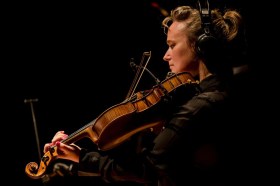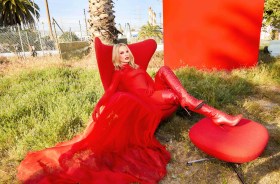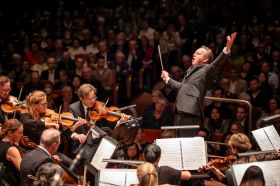‘We can forgive a man for making a useful thing as long as he does not admire it. The only excuse for making a useless thing is that one admires it intensely.
‘All art is quite useless.’
Had he lived to see the world premiere of Oscar, a biographical ballet commissioned by The Australian Ballet and choreographed by Christopher Wheeldon OBE, instead of dying penniless in Paris in November 1900 at just 46 years of age, Oscar Wilde may perhaps have reconsidered this famous aphorism from the preface of his 1891 novel, The Picture of Dorian Gray.
Since at least the 18th century, ballet has encouraged same-sex attracted dancers to “play straight” (to paraphrase remarks made by David Hallberg, The Australian Ballet’s Artistic Director at Oscar’s post-show reception on opening night), through a seemingly endless focus on heterosexual romances in the art form’s canonical works. With Oscar, ballet’s closet doors are flung wide open, ensuring that future generations of gay men can aspire to dance leading roles that reflect their authentic selves instead of having to “play it straight”. The art of Oscar, then, is clearly far from useless.
Continuing a journey that began with Matthew Bourne’s muscular reimagining of Swan Lake in 1995, Wheeldon’s Oscar presents gay love and desire openly and unapologetically on stage. For that reason alone the production is significant. That it also mostly succeeds in fusing together elements of Wilde’s life and writings to present a compelling, composite portrait of the man and his era, makes it more significant still.
Like other retellings of Wilde’s life, Oscar draws upon the writer’s own words to help shape its narrative. But rather than utilising the The Selfish Giant, which shaped the narrative spine of Brian Gilbert’s 1987 film Wilde (starring Stephen Fry, with whom Wheeldon and his collaborator, composer Joby Talbot, discussed their ballet while developing the central story, according to a recent interview with Wheeldon in The Guardian) or The Happy Prince (featured prominently in Rupert Everett’s 2018 film of the same name), Wheeldon has chosen to focus on two separate tales: the tragic fairy tale The Nightingale and the Rose (an allegory for the rise of materialism at the cost of personal relationships in the late Victorian age) in Act I, and Wilde’s only novel, The Picture of Dorian Gray in Act II. Together with Wilde’s memories of his glittering life before his downfall, these two texts play a key role in bringing the ballet to rich and vivid life.
The story begins
Wheeldon’s ballet opens on 25 May 1895, when Wilde (principal artist Callum Linnane in a performance that perfectly balances flamboyance and despair) is sentenced to two years’ hard labour for the crime of gross indecency. A narrator (Seán O’Shea) provides salient details as a whirling throng of bewigged and begowned barristers sweep and bob across the stage, and Wilde’s shock at the judge’s verdict is conveyed with an artfully staged stagger before the court transforms into the prison cell (in reality, one of several jails in which Wilde was imprisoned) where the disgraced Irishman is to spend the next two years of his life.
Wilde’s only way out of this squalid room is through his imagination. Thus we see him recalling happier times spent with his wife Constance (Sharni Spencer) and their sons, a sequence in which the choreography conveys genuine delight and affection between the married couple, while back in his cell, the imprisoned Oscar’s raised legs mark out the passage of time like the slowly moving hands of a clock against his grim cell door.

Other memories – Oscar’s celebrated status in high society, conveyed through choreographic sequences in which crowds first gather around Wilde before echoing and copying his movements; his friendships with the leading ladies of the age, Sara Bernhardt (Benedicte Bemet), Lillie Langtry (Mia Heathcote) and Ellen Terry (Jill Ogai), in which each artist is given her own time to shine through choreography that evokes the dance styles of the period as viewed through a modern lens – are interspersed with the tale of The Nightingale and the Rose, with the role of the Nightingale danced exquisitely by Ako Kondo.
Beautiful as such scenes are, they occasionally seem lacking in emotional authenticity. Consequently, Oscar is glorious to behold, but its beauty sometimes feels only skin-deep. Greater attention to conveying the emotional intensity of scenes in Act I, especially those drawing upon The Nightingale and the Rose, would enhance the production’s impact overall.
Into the underworld
Act I also sees Wilde’s first introduction to the journalist Robbie Ross (an expressive Joseph Caley), an openly homosexual young man whose initial flirtation with and eventual seduction of Oscar is played out under Constance’s oblivious eye through a vividly realised pas de trois, in which Robbie places his hand on Oscar’s thigh while Oscar is gently stroking his adoring wife’s face.
(Ross’ seduction of Wilde in 1886 was Oscar’s first foray into homosexuality according to biographer Richard Ellmann, though Neil McKenna, whose The Secret Life of Oscar Wilde is quoted in the ballet, suggests Oscar may have already begun acting on his homosexual desires as a student at Oxford, or was at least actively aware of such feelings circa 1876, when he wrote the homoerotic and unpublished poem, ‘Choir Boy’.)

Leading Oscar out into the night and abandoning Constance, Robbie introduces Wilde to a clandestine world of molly houses (as gay bars of the time were known) and same-sex attracted men in an exuberant sequence featuring the appearance of two drag queens, Harri (Marcus Morelli) and Zella (Cameron Holmes): a clear reference to the notorious Victorian era drag queens Fanny and Stella, aka Ernest Boulton and Frederick Park, whose trial took place in 1871, more than a decade before Ross and Wilde became lovers (and whose lives are the subject of another book by Neil McKenna).
Utilising slapstick – and literal slaps – to evoke the bawdy atmosphere of the music hall, the tone of the piece soon darkens. The architectural elements of the set are lowered to depict Oscar’s ventures into the Victorian sexual underworld, where the swirling tides of desire, artfully evoked through an encircling mass of dancers whose legs sometimes swing lasciviously as they surround him, threaten to drag Wilde down.
Simultaneously, the story of The Nightingale and the Rose reaches its own, tragic conclusion, with the short story’s subtextual theme the connecting thread between the seemingly disparate parts of the Act – instead of materialism corrupting Oscar’s relationship with Constance, the ballet seems to saying, it is Wilde’s need for self-actualisation and the drive of his newly-awakened sexuality that is pushing him away from his family life.
In Act II, as illness and injury drive the imprisoned Oscar to the brink of madness, his memories of writing The Picture of Dorian Gray (a remarkably frank novel for its time in terms of its coded references to homosexuality) are interspersed with his growing infatuation for and subsequent relationship with Lord Alfred “Bosie” Douglas (Benjamin Garrett). A sex scene between the two, featuring legs hooked around waists and feet hooked through legs to support athletic counterbalances, dramatic lifts with splayed legs evoking mutual oral pleasure, and muscular floorwork does not shy away from the physical nature of the men’s relationship, and a kiss, when it comes, feels authentically passionate and real – a credit to the work of intimacy coordinator Amy Cater, as well as the commitment and skill of the dancers.

Bosie is shown to be petulant and selfish, and Wilde’s subsequent descent into a sordid world of rent boys and potential blackmailers (young men whose presence Oscar found ‘delightfully suggestive and stimulating. It was like feasting with panthers; the danger was half the excitement,’ he wrote in De Profundis, his confessional and accusatory letter to Bosie penned in Reading Gaol) is echoed by scenes played out from Dorian Gray – in which Oscar himself embodies the once-beautiful portrait that withers and decays while its increasingly depraved subject stays young and beautiful. Linnane’s mastery of movement and character are beautifully displayed here, employing posture alone to depict the ravaged portrait, while movement sequences convey Wilde’s corresponding emotional and mental decline.
Oscar’s self-recrimination and descent into illness are matched by Dorian Gray’s embrace of excess, and it is here that the production seems to temporarily lose its way, if only briefly. Evoking decadence through dance, accompanied by a nightclub-like musical beat, recalls a similar scene that briefly detracted from Kip William’s cine-theatre production of Dorian Gray for Sydney Theatre Company, though, like that production, the troublesome sequence is relatively short-lived. Thereafter, Oscar finds its feet again, fully embodying the venom with which Wilde was prosecuted after being stalked and harried by Bosie’s father, the malevolent Marquess of Queensberry, and culminating by coming full circle, back to the trial which opened Act I.
Technically bold
In addition to its striking choreography and strong performances, Oscar is also memorable for its sophisticated costume design by Jean-Marc Puissant, which sometimes incorporates text from Wilde’s works (such as upon the black frock coat worn by Lord Henry Wotton in the Dorian Gray sequences) and features a high level of attention to detail. During Wilde’s time in Reading Gaol, for example, his prison jacket bears the identification ‘C.3.3.’ – referencing the nom de plume under which his The Ballad of Reading Gaol was originally published.
Jody Talbot’s original score is rich and imaginative, utilising sensual strings to highlight desire, playful brass for bawdier moments and an industrial-style whine to evoke the tinnitus Wilde suffered after falling and injuring himself in prison (though the latter sound is perhaps too prominent on occasion, slightly detracting from the performances on stage).
Digital projections illustrate the duration of Wilde’s time in prison and the overwhelming presence of his wit and words in the lives of those who knew him, and the overall set design (Puissant again) is clean and efficient, with a handful of objects sometimes flying in to evoke a change of scene or the oppressive nature of Wilde’s time in prison (the door of his Reading Gaol cell, which has subsequently been exhibited in the UK, is starkly and poignantly recreated).
The opening of Oscar at The Regent Theatre marks the start of the company’s extended residency in the venue while its usual home, Arts Centre Melbourne’s State Theatre, is renovated as part of the Arts Precinct Transformation project. The stage has been raised (the inclusion of a small lip at its edge has the unfortunate impact of sometimes concealing the dancers’ feet and obscuring elements of the floorwork for those sitting near the front of the stalls) and the orchestra pit opened up and extended, so that the musicians of Orchestra Victoria are playing in plain sight. Their performance on opening night, under the baton of Music Director Jonathan Lo, more than matched the artistic excellence displayed on stage.
Read: Theatre review: Hamlet, fortyfivedownstairs
Oscar is a masterful work, though it falls short of being a masterpiece. Greater emphasis on the emotional aspects of the story in order to bring them up to the same level as Wheeldon’s superb choreographic characterisation, and some trimming of the most excessive scenes would strengthen the production. Nonetheless, it is already a bold and imaginative work – and a thrilling demonstration of The Australian Ballet’s ambition as well as the company’s commitment to an inclusive and exciting future.
Oscar
The Australian Ballet
Synopsis by Christopher Wheeldon and Joby Talbot based on an original idea by Alexander Wise and Christopher Wheeldon
Choreography: Christopher Wheeldon
Composer: Joby Talbot
Stage and costume design: Jean-Marc Puissant
Lighting design: Mark Henderson
Video design: David Bergman
Sound design: Ned Prevezer
Intimacy coordinator: Amy Cater
Christopher Wheeldon’s Oscar includes extracts from Neil McKenna’s book, The Secret Life of Oscar Wilde, copyright Neil McKenna, with kind permission from the author.
Orchestra Victoria conducted by Jonathan Lo
Cast includes: Seán O’Shea, Callum Linnane, Sharni Spencer, Benjamin Garrett, Benedicte Bemet, Mia Heathcote, Jill Ogai, Ako Kondo and Joseph Caley
Tickets: $54 – $289
The Regent Theatre, Melbourne
13-24 September 2024
The Australian Ballet’s Oscar plays at the Joan Sutherland Theatre, Sydney Opera House from 8-23 November 2024 following the completion of its Melbourne season.
This review was amended after publication to clarify that the drag queen characters depicted in Act I are not Fanny and Stella themselves, but new characters based upon them.






